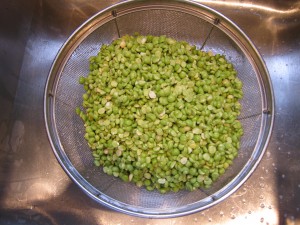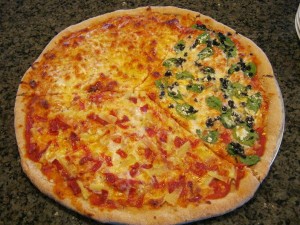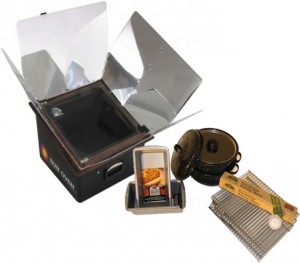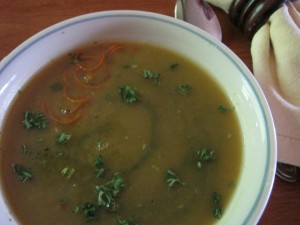 Typically a cold weather food, Split Pea Soup is a hearty meal that can be made entirely from foods that are stored for long term. Split peas last for a year or more in the pantry. Dehydrated carrots, onions and spices are also long term food storage items. If you can your own veggie or chicken broth, or purchase granules or bullion cubes then you’re set. Nothing has to be “in season” to make this filling soup.
Typically a cold weather food, Split Pea Soup is a hearty meal that can be made entirely from foods that are stored for long term. Split peas last for a year or more in the pantry. Dehydrated carrots, onions and spices are also long term food storage items. If you can your own veggie or chicken broth, or purchase granules or bullion cubes then you’re set. Nothing has to be “in season” to make this filling soup.
Here is the recipe and the steps.
Ingredients:
- 1/2 Cup shredded or diced dehydrated Carrots
- 1/4 Cup diced dehydrated Celery
- 1/4 Cup diced dehydrated Onions
- 1/2 Cup dehydrated Potato Cubes(optional)
- 2 Cups Split Green Peas
- 1 TBS Olive Oil
- 1 TBS Garlic Salt
- 1/8-1/4 tsp Cayenne
- 1/4 tsp Cumin
- 2 Quarts of Soup Stock (veggie or chicken or water/bullion equivalent)
First – soak 2 Cups of Organic Split Green Peas over night
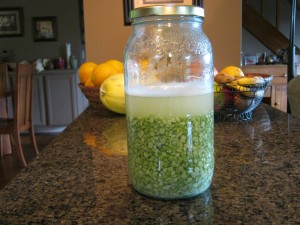 Don’t worry. They will likely look a little ‘frothy’ in the morning, but this is normal.
Don’t worry. They will likely look a little ‘frothy’ in the morning, but this is normal.
Just be sure before you go to sleep that you have covered the Split Peas with more than double their height in water. For example, if the peas are about 4 inches in depth, put 8 inches of water ABOVE THE TOP. Twelve inches all together. Because the peas will soak up a LOT of liquid over night making them easier to cook to smooth the next day.
After soaked, drain them before moving on with the rest of the recipe.
Mean while, back at the soup pot: Add about 1 Cup of the liquid to the base of the soup pot, put in all of your dehydrated veggies and let soak for a little while (approx 30 minutes).
Now add remaining liquid/broth, Drained Split Peas and spices. Cook on low heat for 2-4 hours. Stirring occasionally.
Either use a stick blender and put in the pot whirring until creamy or transfer by one cup at a time to a blender to blend most of the soup to creamy. For a chunkier soup, blend only half of the soup and leave the rest as is. Combine. For a smoother soup, blend it all. Serve hot.
Serve with freshly baked bread for a real treat.
This can even be pre-made with the dry ingredients in a cute little gift jar. Simply put the Split peas as the base and a small decorative bag full of the other dehydrated foods combined with the herbs as a topper inside the jar.
EnJOY!
Home 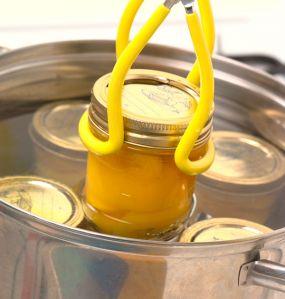 Canning has been around for far longer than our store-bought canned products of today. It is an old skill that is making a come back during these tougher than normal economic times. And why not? Buying fresh foods and learning how to make them last long into the next few seasons is often the most economical way to eat without attempting to live off of preservative laden boxed mixes.
Canning has been around for far longer than our store-bought canned products of today. It is an old skill that is making a come back during these tougher than normal economic times. And why not? Buying fresh foods and learning how to make them last long into the next few seasons is often the most economical way to eat without attempting to live off of preservative laden boxed mixes.
The history of canning can be traced back as far as Napoleon Bonaparte in the 18th century. He experimented for over 15 years and finally realized that if food is sufficiently heated and sealed in an airtight container, it would not go bad. Wine was among his very first commodities to attempt to preserve in this manner. I mean, priorities are priorities, right?
Although this skill may seem a bit old fashioned it is gaining new ground as grocery prices rise. Men and Women from their 20’s to their 60’s are learning this fine art of food preservation. It is as safe as it is ‘green’ (earth friendly). The cans are reusable glass and do not leach BPA into the food like the white lining of the commercial cans do. Even the lids don’t have to be tossed if you purchase the Tattler Lids (also BPA free). This is much better on our environment and our bodies.
The difference between water bath canning and pressure canning is easily determined by the acidity of the food. There are several good (and reasonably priced) books to help you know which method to use and how long to process the food. There are also tools of the canning trade that you can get for less than you may think, making the home canning process an old skill that will help you stretch your food bill for seasons to come.
With a little practice, you can easily both pressure can or water bath can almost every single food you may need. The food then stores for years without the aid of electricity.
If I can can – then you can can – we can all can!
Blessings and enJOY the journey!
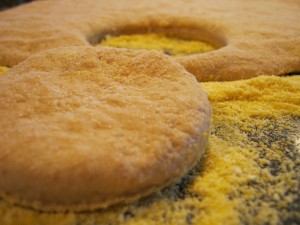 One of the biggest joys of freshly milled whole wheat at home is experimenting and finding out just what can be made. Having the whole grain on hand, milling it and using it in a variety of ways just opens the doors wide for budget stretching and nutrition!
One of the biggest joys of freshly milled whole wheat at home is experimenting and finding out just what can be made. Having the whole grain on hand, milling it and using it in a variety of ways just opens the doors wide for budget stretching and nutrition!
I used to think that English Muffins were one of the most difficult things to make. I mean, look at them! They are small discs of toasty goodness with the pull apart texture that makes them toast better than any slice of bread. Not to mention, we have always made Egg-Mc-Miller-Muffins for special occasions and I was afraid I’d mess things up by trying to make a Whole Wheat English Muffin. Boy, was I glad to be WRONG!
The May 31st Newsletter will have the full recipe and steps for making your own whole wheat English Muffins. Trust me, if I could do it – you can do it! So be sure you’re signed up for the Newsletter. Also, we’ll be 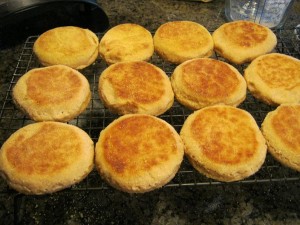 having a live video class on this – so you can see the techniques and ask questions! We’ll notify you of that class in the newsletter too!
having a live video class on this – so you can see the techniques and ask questions! We’ll notify you of that class in the newsletter too!
I’ll leave you with my favorite picture from my adventures in Whole Wheat English Muffins!
EnJOY playing with your food! You may never know what you can do until you try!
Home-made Whole Wheat (freshly milled!) Pizza Crust can be made easily ahead of time to make even the most hectic evening meals both fast and healthy. With variety and choices of toppings it can be a great family pleaser! I mean, who doesn’t like to choose their own toppings on pizza, right?
From fresh herbs to your own simply made tomato sauce (ground tomatoes) there are endless possibilities to toss on top of this crust and have dinner in a flash. The secret is making several of these healthy crusts ahead of time and freezing them!
Here’s the simple way to do it.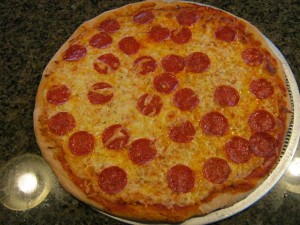
First use freshly milled whole wheat in your favorite recipe. You can see mine on our VIDEO ARCHIVES.
Second, buy the large turkey roasting bags at the grocer.
Third, when making these only par-bake them at 350 for between 8-10 minutes until lightly cooked.
Then cool completely, bag and put in the freezer. Stack them inside the turkey roasting bag, twist tie and freeze! Ready to be used when you’re short on time, but don’t want to short change your family on healthy food!
Then when you have only 15 minutes to have dinner on the table – pull one out, decorate as you like and bake for about 10 minutes at 400 degrees. Within less time than it takes to drive to the take-out pizza place you’ve got a far healthier and budget friendly dinner ready to go!
By using freshly milled whole wheat – you also enjoy the flavor of the pizza without the over powering taste of the bagged whole wheat flour ruining the sauce, cheese and toppings! So if you’ve not thought of a mill you’d like yet…please view our GRAIN MILL COMPARISON CHART to get started!
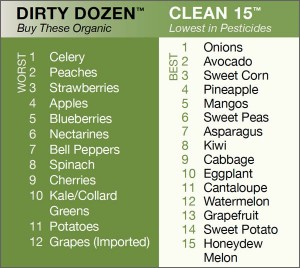 If there were one budget benefit to the rising food prices of our current economic climate, it would be that the prices of ‘regular’ produce have virtually met the price of organic produce. Now making the choice between the two options does not have the same wide cost comparison. Yet again, knowing just what to purchase as organic and what is lower in pesticides is always a good thing to keep in mind when trying to provide healthy foods on a budget.
If there were one budget benefit to the rising food prices of our current economic climate, it would be that the prices of ‘regular’ produce have virtually met the price of organic produce. Now making the choice between the two options does not have the same wide cost comparison. Yet again, knowing just what to purchase as organic and what is lower in pesticides is always a good thing to keep in mind when trying to provide healthy foods on a budget.
There are lists like the one pictured here in this article that can be helpful in deciphering just what to spend your money on when planning your grocery budget. Organic Produce and Low Pesticide Produce are categorized into the ‘Dirty Dozen’ or the ‘Clean Fifteen’. The trick here is to remember them. I can barely remember to take the list of needed items and coupons, so this additional list will likely get left on the kitchen counter instead of in my hand at the grocery store. However, there are a few tips and tricks to help you remember what are the best choices:
- Print out and potentially laminate the list above and keep it in your wallet or check book. This way it is always with you, even when you happen upon a farmers market or fruit stand. I also do this with printer cartridge information for the copier.
- Forgot your list? No worries, just remember that most of the fruits and vegetable s that you also eat the skin or peel (or that the peal is fuzzy and absorbent) you will want to purchase as organic. Produce that you peel or remove the outer layer are often lower in pesticides both during the growing process and you habitually lower the intake by removing the outer layer before consuming.
- Most produce has 4 to 5 numbers on the sticker. Look at the first one to know what you are getting: Starts with a “9” – Organically Grown and non GMO. Starts with “3 or 4” – Conventionally grown, not genetically modified (non-GMO), but also not organic. Starts with an “8” – Genetically modified (DNA altered), so hate eight.
- Last but certainly not least, and definitely the most trustworthy and budget friendly approach….grow your own! Not only will it save money, you’ll have the satisfaction of knowing what went into the process, appreciate the end product and enjoy the taste far more!
Hopefully this will help as you approach your produce selection to feel you are confidently spending your hard earned budget money on food that best nourishes your family. Listen to the April 18, 2012 episode of “Encouragement in the Kitchen” for more insight and encouragement about this topic.
Next week on April 10th, 2012 Millers Grain House is delighted to be offering a Solar Cooking Class at the local fairgrounds. Given the price of electricity and the need to practice greener, self-sustaining skills, the Global Sun Oven is becoming one of our new favorite cooking options.
The Dehydrating Prep Pack makes this a very versatile oven that does far more than slow cook! It’s not your chintzy solar cooker.
The Global Sun Oven bakes, broils, steams, dry boils eggs, purifies water, dehydrates and can be used to sprout! This is the only solar cooking device that we have found to reach baking temperatures of up to 400 degrees. Most people know that to bake muffins or bread, it must reach and sustain this temperature. It does!
At the upcoming class we will demonstrate baking muffins and meat and dehydrating a 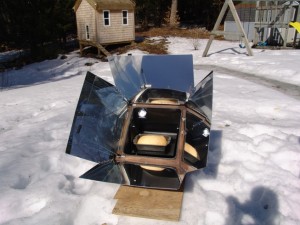 variety of foods. Each participant with get to play with the Global Sun Oven and see just how easy it is to use. This is my favorite new toy, I mean, tool! So much so, that it feels like I’m playing with an easy bake oven!
variety of foods. Each participant with get to play with the Global Sun Oven and see just how easy it is to use. This is my favorite new toy, I mean, tool! So much so, that it feels like I’m playing with an easy bake oven!
The versatility and durability of the Global Sun Oven has made it to be my only recommended Solar Oven to date. There really is no match to it.
Stop by here and see how my very first loaf of freshly milled whole wheat bread in the Global Sun Oven did! It’s the video in the lowest left hand corner. EnJOY!
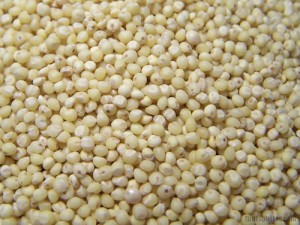 Low gluten and gluten-free items can be very expensive to buy in the store. So if you want to know what you’re getting and if it ‘s right for your gluten-free or lower gluten diet, it would be good to learn a little more about the grains you can use. I began my journey in home-milling because of a diagnosis of gluten sensitivity. Thankfully I found it was the processing of wheat flour that was my issue, not the gluten (as is the case in many people’s mis-diagnosis) and I can again eat freshly milled whole wheat. But I did learn of several grains that work well for a lower gluten or gluten-free diet.
Low gluten and gluten-free items can be very expensive to buy in the store. So if you want to know what you’re getting and if it ‘s right for your gluten-free or lower gluten diet, it would be good to learn a little more about the grains you can use. I began my journey in home-milling because of a diagnosis of gluten sensitivity. Thankfully I found it was the processing of wheat flour that was my issue, not the gluten (as is the case in many people’s mis-diagnosis) and I can again eat freshly milled whole wheat. But I did learn of several grains that work well for a lower gluten or gluten-free diet.
Because these grains all contain a trace to no gluten, they will all require some kind of binding agent in the recipe in which you use them. Gluten protein forms strands to hold dough together when baking. These grains do not have those strands so you cannot replace the milled flour of a low to no gluten grain exactly for wheat flour.
Millet (pictured above) is one of the staples in a gluten free diet. Millet can be cooked as a replacement for couscous (which is a wheat pasta, not a grain) or milled into a flour.
Quinoa is another low gluten grain. It is very high in protein and also cooks well whole.
Rice is a gluten-free grain. When milled the flour is very fine and suitable for thickening sauces.
Rye is an extremely low gluten grain. The flour is suitable for baking flat breads and using in batter bread mixtures.
Corn is low gluten. There is a trace amount of gluten & starch in some corn meals.
Oats can contain a trace amount of gluten. If you suffer from Candida or Celiac’s , be sure the oats you purchase are labeled ‘Gluten-Free’ since not all oats are gluten free.
Spelt is another grain often used in low to no gluten diets, but it does indeed have trace amounts of gluten in it. It can be kneaded but only for a short time after which over kneading causes the dough to become very sticky.
Kamut is not low or gluten-free. Kamut is an ancient grain akin to today’s wheat derivative.
Let me encourage you that if you have been diagnosed with a gluten sensitivity or a gluten intolerance, you may be able to enjoy whole wheat bread again if you mill the wheat at home and use it fresh. However, if you have been diagnosed with Candida or Celiac’s consider milling these low to no gluten grains at home to save yourself some money and give you variety in your diet.
Whole wheat is so good for you compared to white bread. There is no denying that the health benefits of whole wheat out-weigh those of it’s white flour counter part. But a loaf of ‘healthy bread’ in the store is getting increasingly more expensive! Not to mention, many ingredients in the so-called healthier breads really are still not that good for you!
So many folks turn to trying to make whole wheat bread at home only to be disappointed in texture, taste, density, shape, gooey and/or short stocky loaves. Also, many recipes give a list of additional ingredients that are supposed to make white flour bread more ‘healthy’ and the cost per loaf begins to sky rocket.
It’s enough to make someone give up and go back to the colon clogging white loaf bread in the store! NO! Please for your body’s sake – don’t do that!
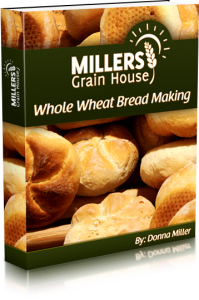 It is with the utmost of anticipation that I am delighted to announce the recent release of my newest e-book. As a better teacher, I can teach a class on this subject and everyone leave with a perfect loaf of bread, even if they’ve never touched whole wheat flour before. Live classes are my favorite! I love to see the joy and confidence on the faces of the participants as they take home their creations to share!
It is with the utmost of anticipation that I am delighted to announce the recent release of my newest e-book. As a better teacher, I can teach a class on this subject and everyone leave with a perfect loaf of bread, even if they’ve never touched whole wheat flour before. Live classes are my favorite! I love to see the joy and confidence on the faces of the participants as they take home their creations to share!
This book has been a labor of love for me. Usually in a class, I have the benefit of conversation and hands-on demonstration. In this book, I’ve endeavored to show and describe techniques and tips that we discuss, demonstrate and do in a live class together. I hope it helps you on your way to producing consistently tasty and beautiful loaves of whole wheat bread for your family!
You can follow this link to see what others say about it and get a copy of your own: Whole Wheat Bread Making
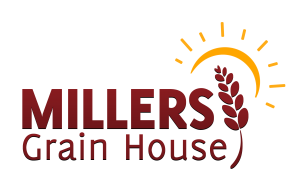 Maybe you’ve stopped by and wondered what is going on at Millers Grain House!?! Things look a little different and there is a new logo at the page top.
Maybe you’ve stopped by and wondered what is going on at Millers Grain House!?! Things look a little different and there is a new logo at the page top.
Don’t worry, Millers Grain House has not changed hands – we’re doing some house keeping to serve you better. We are growing and we are getting busier. With that, we also want to be sure to give you the best possible service we can! We’ve put everything that was once in different places across the web in a more user friendly one stop place: http://www.millersgrainhouse.com
And more than offering whole grains, wheat, grain grinders and mills – we want to be able to serve you with in other areas as well.
Some of the changes already include:
- Easy access to the last 3- 6 months archives of m weekly radio show: Encouragement in the Kitchen.
- An ever expanding FAQs and Knowledge Base section that covers everything from which whole grain to use to questions about grain mills/grinders and how to store grain and other food.
- A brand new Support Team that will not only organize your questions so they are answered in a more timely fashion, but by asking – you help grow the Knowledge Base!
- Clearer categories to get you where you want to go: Main Store – Bulk Delivery Route – Classes
- As always, a way to stay in the loop! Subscribing to the Newsletter (risk nothing and get a Free Recipe each month while we stay connected!)
- YOUR Testimonials are running along the bottom of the home page! Thank you! (o:
But wait! There’s more! NEW things coming SOON:
- Free Webinars with live lessons, question & answer sessions and recipes!
- A Jazzed up YouTube channel with some new faces to continue Free Videos for you!
- A Discussion Forum to share your whole food and whole grain trials and triumphs!
- Recipe Sharing!
- The Member’s Group with perks of its own with exclusive online classes, exclusive discounts, exclusive downloads and discounted merchandise.
It is our desire to serve you the best best we possibly can! With these new and exciting additions and the ones we’ve organized in place already – it is our hope that you will settle in and join the ‘family’ here at Millers Grain House. We’d love to have you share with us!
Best Blessings and enJOY the journey!
Donna Miller

